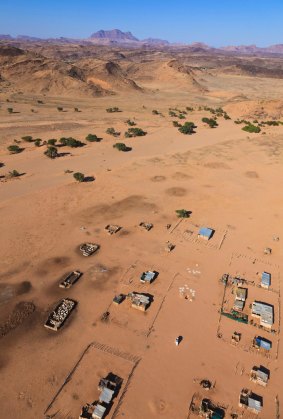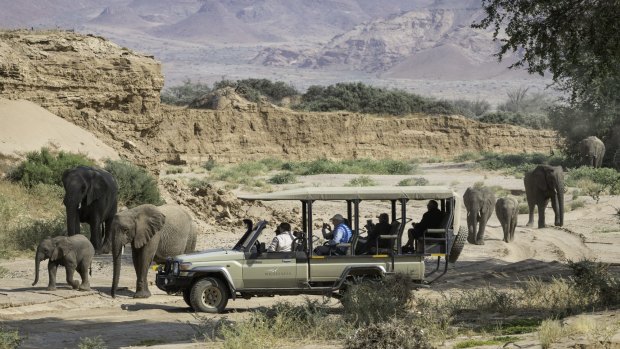This was published 4 years ago
De Riet, Namibia: Desert safari meet with the Riemvasmaker community
By Nina Karnkikowski

Southern Damaraland is not an environment you would expect humans to live in.Credit: Alamy
Stepping out of my safari vehicle at De Riet village, in the middle of the desert in Namibia's southern Damaraland, I feel as though I am stepping onto the surface of the moon. Arid gravel plains stretch out around me, fringed by low, purple mountains. It is stiflingly hot, almost completely barren, and just about the last place on Earth you would expect human beings to be able to survive.
And yet survive is exactly what the Riemvasmaker people, who live in the handful of aluminium shacks we're now walking towards, have done since they were first "relocated" here in 1973. Refugees who fled tribal conflict in Namibia in the 1870s and settled in neighbouring South Africa in a so-called coloured reserve, the Riemvasmakers were then forcibly moved here when the apartheid government decided to use their villages as a military testing site.
My local Bench Africa guide ushers me through a crude wooden fence and into a courtyard area beside a turquoise-coloured shack, where we're greeted by 79-year-old local William Basson. Within minutes of offering us seats in the shade, Basson begins telling us his story in Afrikaans, using my guide as translator, as his two-year-old grandchild plays in the dirt beside us.

De Riet Namibia with Bench Africa tours.Credit: Bench Africa
"In 1973, my family and I were put on a train called Black Spot Removal and dropped off in Namibia, which at that point was South West Africa," says Basson.
He and hundreds of other Riemvasmakers were left in a place called Otjiwarongo, without shelter or protection. But lions in the area were eating their livestock, all they had in the world, and so the following year they were moved here to De Riet. At the time, it wasn't much better. Just empty space, far from their ancestral home and cut off from the world – no telephones, no transport, no school, no clinic, nothing.
Basson and the other villagers had no choice but to start from scratch, figuring out how to live in harmony with the desert-adapted elephants that also lived (and continue to live) in the area. They started to build simple huts, a small schoolroom and other basic infrastructure for the settlement. Slowly, it began to feel like home.
In 1994, when South Africa began to transition from apartheid and a democratic government was formed, De Riet's Riemvasmaker people were offered a return to the land from which they had been forcibly removed 21 years earlier. By then, however, about 200 of them, Basson included, no longer wanted to. "I never wanted to go back, never," says Basson "They must bury me here in Namibia."
Two years later in 1996, Wilderness Safaris, one of Africa's main ecotourism operators, moved into the area and opened Damaraland Camp, the elegant desert lodge I have been staying in. They aligned with the local Riemvasmaker community, training and employing members to work in the lodge and paying them a share of revenue, a partnership that continues to help the community today.
I leave Basson and De Riet with mixed emotions. Distressed by the idea of any person being plucked from their home, forced to abandon what they love and deposited in the middle of nowhere, left to fend for themselves; guilty for having had such an easy life; glad, mostly, that the inhabitants of De Riet were tenacious enough to survive and thrive out here in the desert, and that they and their grandchildren now have a place they so strongly identify as home.
TRIP NOTES
Nina Karnikowski travelled as a guest of Bench Africa.
MORE
FLY
South African Airways flies from Perth to Johannesburg daily (11 hours), then connects to a two-hour flight to Windhoek, Namibia, using codeshare partner Virgin Australia. See flysaa.com
EXPERIENCE
Bench Africa's 11-day self-drive safari itinerary includes a visit to the De Riet community, and other Namibian sites including Sossusvlei, Damaraland and Etosha National Park. From $4680 a person. See benchafrica.com
Sign up for the Traveller Deals newsletter
Get exclusive travel deals delivered straight to your inbox. Sign up now.